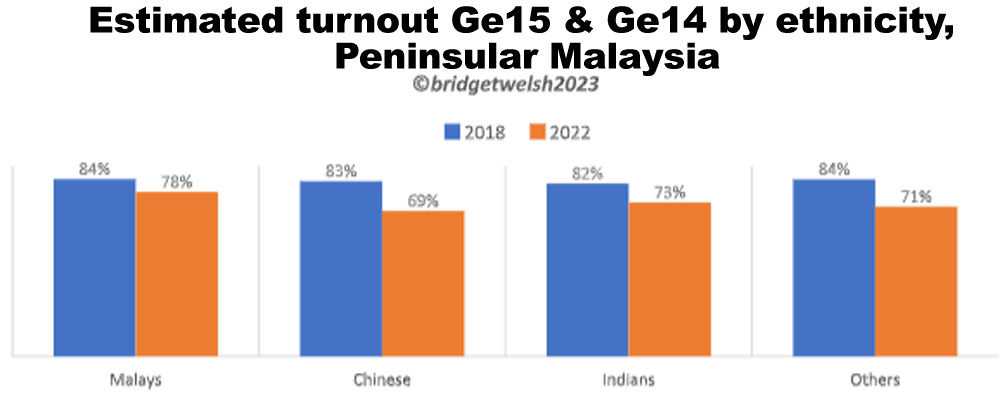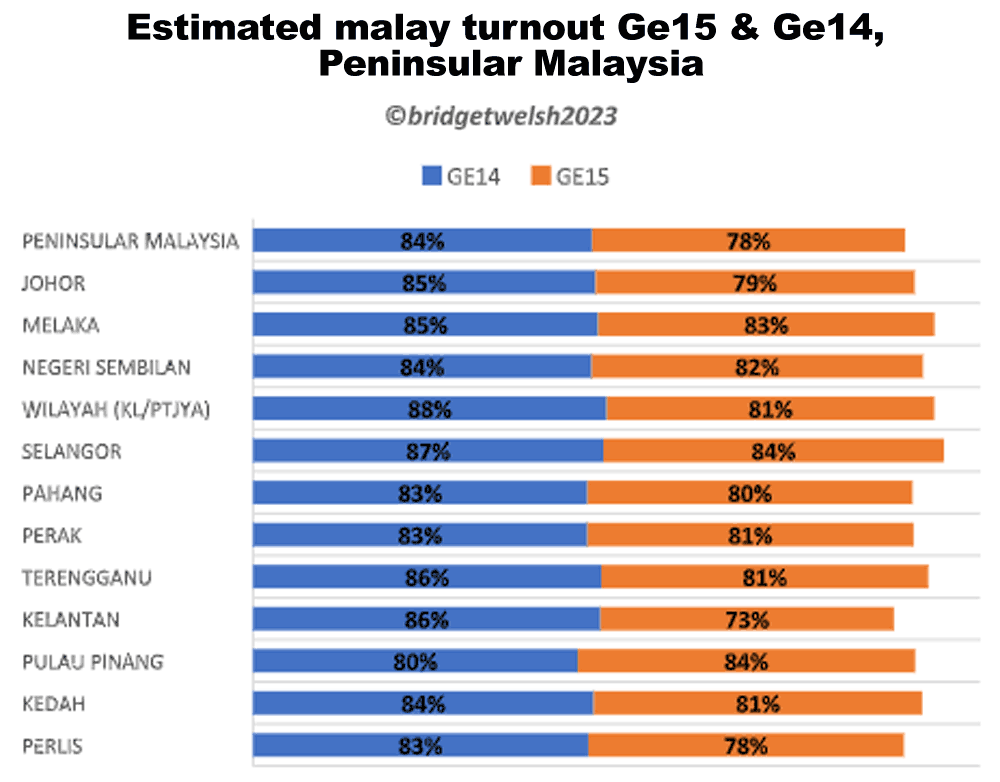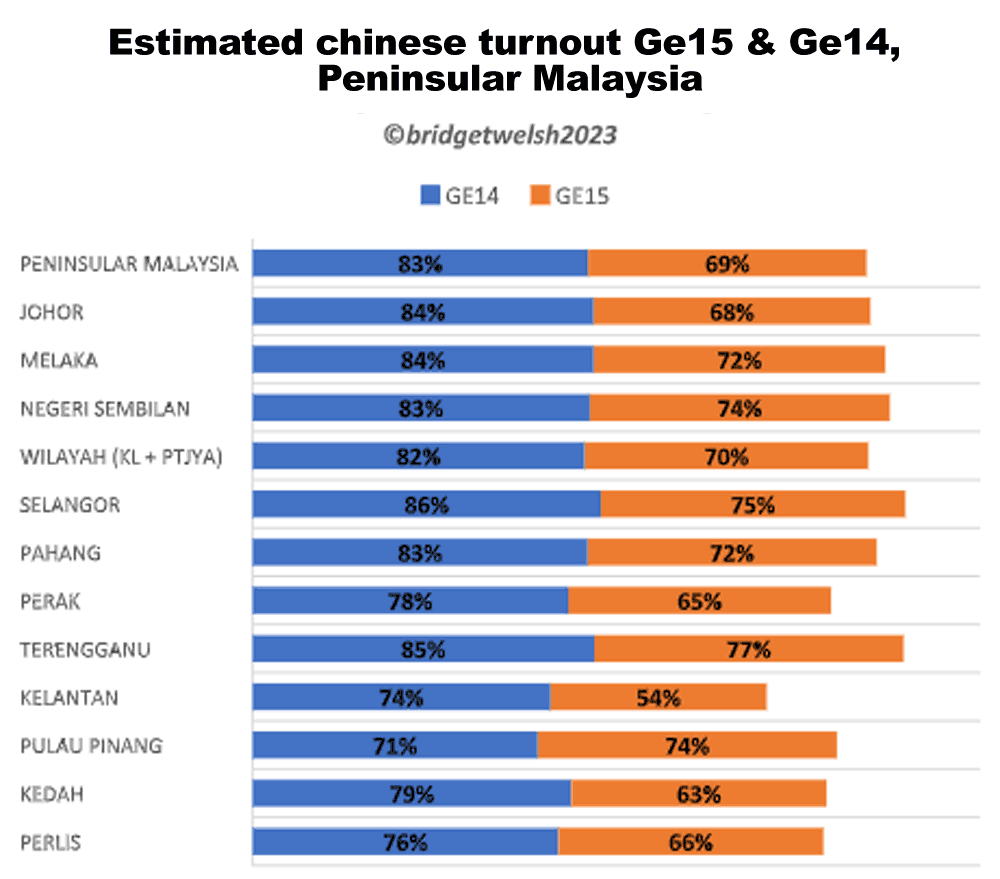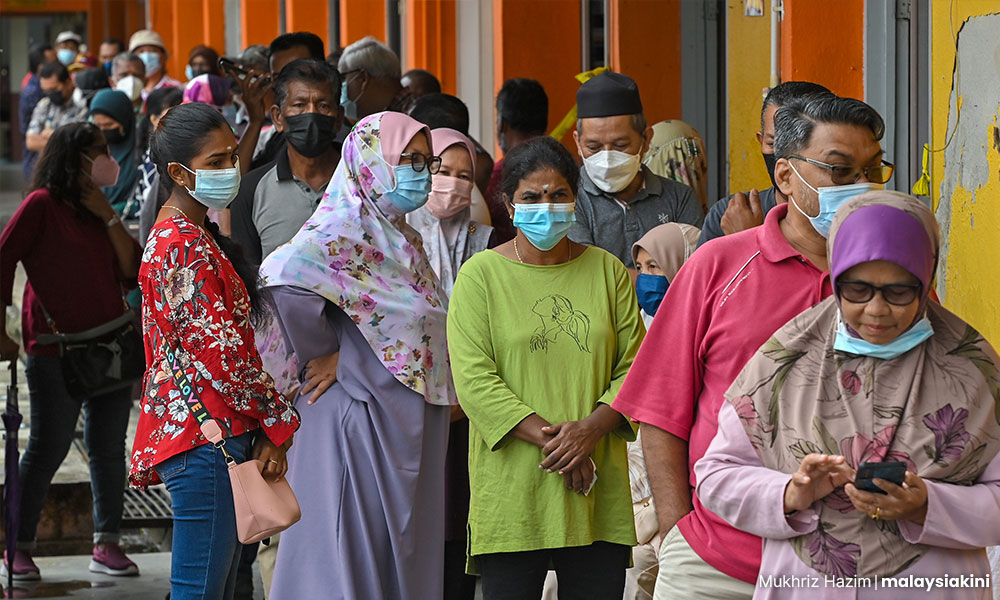Last December, PAS president Abdul Hadi Awang made the unfounded claim that Chinese turnout was higher than Malay turnout due to Malays being away on the haj. My analysis of ethnic voting behaviour in the 15th general election (GE15) found otherwise.
This second piece analyses voter turnout through an ethnic lens with a focus on Peninsular Malaysia (Sabah and Sarawak will be covered in separate pieces).
Beyond the numbers across communities, the findings suggest that turnout varied across Malaysia and shaped electoral outcomes, generally boosting Perikatan Nasional (PN)’s fortunes while undercutting those of Pakatan Harapan and Umno.
In fact, contrary to the incorrect Hadi narrative, higher Malay turnout improved PN’s chances.
At the same time, comparatively lower Chinese turnout reduced the chances of Harapan candidates, although often it was not turnout alone that impacted the final results in most of this coalition’s losses.
For all the major coalitions, ethnic swings in support – discussed in later pieces – proved to be more decisive than turnout.
What the turnout findings by region clearly indicate, however, is the need to improve the country’s postal voting system. Within Peninsular Malaysia, comparatively more voters from more remote areas such as Kelantan, Kedah, and Perak were not able to vote.
While there have been gains in enfranchising voters through Undi18, the lack of reform in postal voting especially hurts those who could least afford to return to vote from outside Malaysia.
Malaysian turnout in context
Let’s start with a look at turnout broadly in the last election. Turnout in Malaysia is high, especially when compared to the rest of the world. The impact of expanding enfranchisement via Undi18 and automatic registration had a positive impact on participation, bringing more Malaysians to the polls.
Yet, the share of voter turnout in GE15 declined. This was to be expected given the increase in voters, some of whom did not even know their names were on the electoral rolls. Nationally, turnout dropped from 82 percent in GE14 to 74 percent in GE15.
This varied among communities. At an estimated 14 percent, the largest decline in voting occurred among Chinese, followed by other communities such as bumiputera from Borneo in Peninsular Malaysia at an estimated 13 percent and Indians at an estimated nine percent.
The turnout drop among Malays was modest, estimated at six percent, the lowest decline of all the communities.

Turnout is shaped by a variety of factors, including the capacity of the parties to mobilise voters to come out to vote through machinery, resources, and social media engagement, issues in the campaign, and the level/form of contestation in an area.
Studies find that voters opt to stay home when they feel their votes don’t count or when the party or coalition they have long supported treats them as if they don’t count.
In GE15, the higher level of contestation among Malay political parties brought more Malays to the polls compared to other communities.
Malay voters were more mobilised through the machinery of parties, including the use of resources/financial incentives to bring them to the polls. Given that ethnic support of the Malay community favoured PN in GE15, this boosted PN’s performance.
Harapan was able to increase Chinese (and Indians as will be shown in the next piece) turnout from the Johor and Malacca state polls.
From an estimated 43 percent in the 2022 Johor state election, turnout for Chinese and Indians in the state was an estimated 68 percent in GE15. From an estimated 68 percent in the 2021 Malacca state election, turnout for these groups was 72 percent in GE15.
Nevertheless, turnout among the Chinese was the lowest of all communities and did not reach GE14 levels. Harapan still faces a gap in its appeal among Chinese voters who are choosing not to vote compared to the past.
Covid-19 also continued to impact turnout in GE15, with the effect primarily an economic one as many outstation voters could not afford to go home to vote, especially those who did not receive financial support to do so.
This reinforces the call for greater improvements to postal voting, as the failings of the system discriminate most among those who cannot afford to return home to vote.
Estimated Malay voter turnout
A closer look at the estimates of Malay voting by state reveals that voting among Malays was highest across all the states and did not vary significantly.
The PAS stronghold of Kelantan was the exception; it reported the lowest national voter turnout (below that of Borneo).
In part, the ‘outstation’ factor helps us understand the lower turnout. The lack of competition was also at play; the fact PAS emphatically dominates Kelantan politically made many of the contests less competitive.

The highest estimated turnout among Malays was in Selangor, Penang, Malacca, and Negeri Sembilan - more multi-ethnic areas of Malaysia where electoral competition was high.
Estimated Chinese voter turnout
There was more variation regionally in Chinese turnout. At an estimated 54 percent, Kelantan reports the lowest, with turnout the highest in Terengganu at an estimated 77 percent.
Here too, the outstation and competition factors were evident. At an estimated 65 percent in Kedah and 65 percent in Perak, levels were lower in states with many outstation voters.

Where turnout mattered
To look at the impact of turnout, my focus was on the close, marginal seats.
Generally, turnout was comparatively less electorally decisive than it was in the state elections of Malacca and Johor. In those elections, turnout drops alone impacted outcomes. In GE15, it was a combination of turnout patterns and important ethnic shifts in support, with the latter more important.
There are three findings regarding turnout by ethnicity’s effect on outcomes.
First, PN received a Malay turnout boost. The greater estimated Malay turnout in places such as Selangor, Penang, and Malacca contributed to victories in these states, from Tasek Gelugor to Tangga Batu, Kapar, and Jasin. PN was able to get over the line in larger margins through its mobilisation of the Malay community.
Second, Harapan lost ground due to lower Chinese turnout, especially in areas with outstation Chinese voters. This is evident in seats such as Lumut and Parit Buntar in Perak, Kuantan in Pahang and Ayer Hitam in Johor. In these constituencies, the outcome would not have changed from a turnout drop alone.

Third, in past elections, disgruntled loyal party supporters opted to stay home rather than vote for another alternative. In GE15, voters came out to vote. Umno voters, for example, did not opt to just stay home in protest. They went to the polling booth.
However, this was not enough as Umno lost seats such as Sungai Besar and Kangar. Here too, turnout was secondary to the broader swings in ethnic support, and in the case of Umno, collapse in support.
Need for reform
GE15 may not be a turnout story in terms of electoral outcomes compared to recent state elections. At the same time, the pattern of ethnic voting is not the story that some politicians claim in their destabilising efforts to stoke racial insecurities.
The takeaway from the turnout numbers in GE15 is instead the need for further reforms, to make the process of voting easier, and to reduce the drop in voting as the number of potential voters increases.
Outstation voters should not be asked to come back, even within Peninsular Malaysia. They should be able to vote in advance or through postal votes.
This need for voting reform to increase turnout is especially salient as state elections approach when traditional voter turnout drops compared to GE15. - Mkini
READ PART 1 : GE15 ethnic voting analysis - Part 1: An introduction
BRIDGET WELSH is an honorary research associate of the University of Nottingham, Malaysia’s Asia Research Institute (Unari). She is also a senior research associate at the Hu Fu Centre for East Asia Democratic Studies and a senior associate fellow of The Habibie Centre. Her writings can be found at bridgetwelsh.com.
The views expressed here are those of the author/contributor and do not necessarily represent the views of MMKtT.



No comments:
Post a Comment
Note: Only a member of this blog may post a comment.